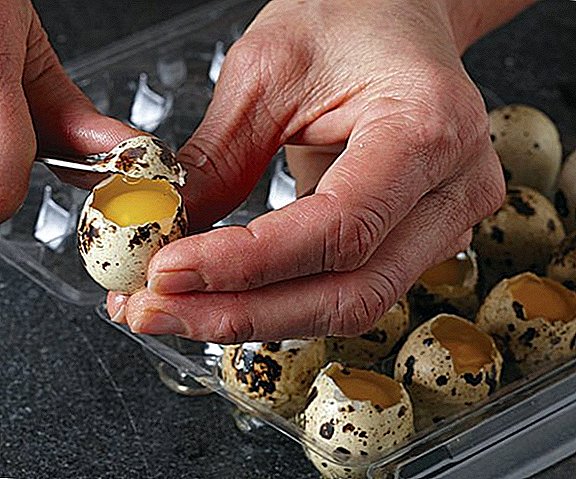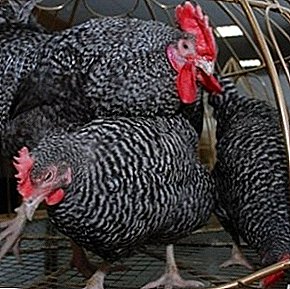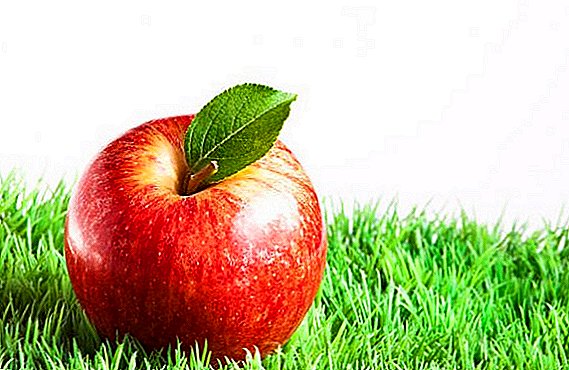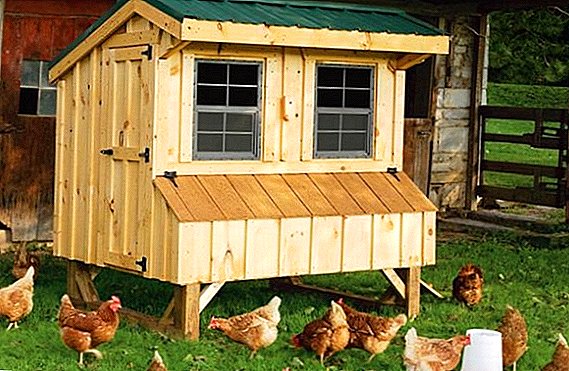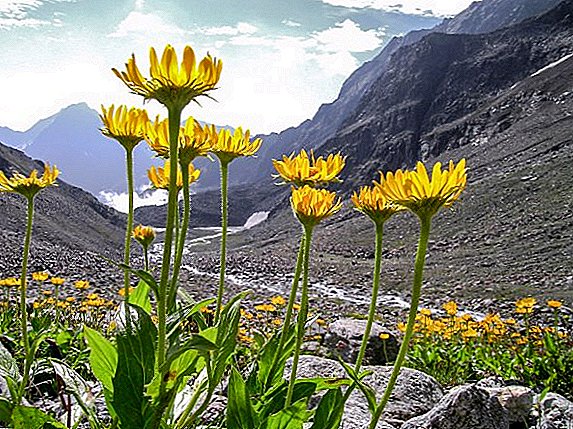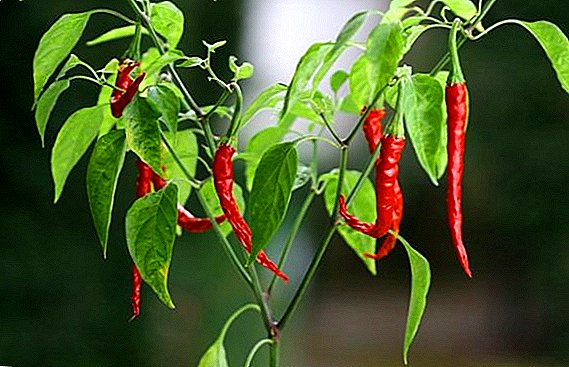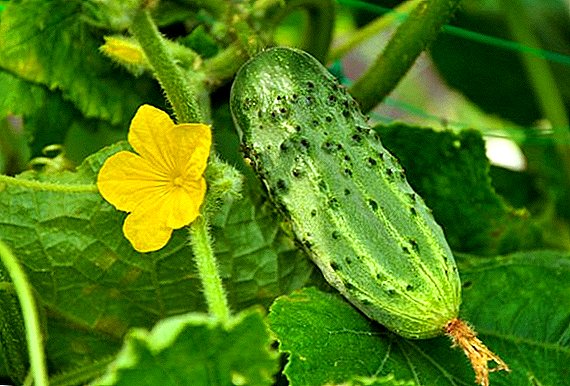 Perhaps the variety of cucumbers "Murom" is known to every gardener and vegetable grower, because he is one of the oldest native Russian varieties of folk breeding. It was bred in the city of Murom (Vladimir region), from which it received the name. This variety has been grown in Russia since the 13th century! Explain the centuries-old popularity of the plant can be its excellent taste, simplicity and precocity - eat these cucumbers succeed much earlier than the fruits of other varieties. In this article, we learn how to grow a well-known variety on your site.
Perhaps the variety of cucumbers "Murom" is known to every gardener and vegetable grower, because he is one of the oldest native Russian varieties of folk breeding. It was bred in the city of Murom (Vladimir region), from which it received the name. This variety has been grown in Russia since the 13th century! Explain the centuries-old popularity of the plant can be its excellent taste, simplicity and precocity - eat these cucumbers succeed much earlier than the fruits of other varieties. In this article, we learn how to grow a well-known variety on your site.
Variety description
This variety belongs to the ultra-fast, bee-pollinating, small-fruited varieties. Shoots grow up to 100-160 cm, richly covered with large, dark green foliage. The bushes are low-stranded, compact, they take not much space on the site. On the main shoot develop male flowers, on the side - female. The plant can be grown both in open ground and in greenhouses. The variety is excellent for growing in the northern regions with harsh climatic conditions: in different parts of Siberia, in the Urals and the Far East.  The advantages of "Murom" cucumbers:
The advantages of "Murom" cucumbers:
- very early ripening - fruits can be harvested 5 weeks after germination, on average 10 days earlier than other varieties;
- high taste of fruits;
- cold-resistant variety, it is possible to grow in very cold climates;
- resistant to powdery mildew, bacteriosis;
- relatively unpretentious in the care.
To bee-pollinated cucumbers can be attributed such varieties as: "Spring", "Paratunka F1" and "Finger".
But you also need to know about the disadvantages of this variety:
- small fruits;
- relatively low yield;
- badly tolerates drought, fruits grow inferior on poor soils.
Important! "Murom "cucumbers extremely quickly turn yellow, outgrow and lose their presentation when it is not collected on time, therefore it is necessary to harvest regularly and often.
Fruit characteristics and yield
"Murom" cucumbers grow to 6-8 cm, in diameter - up to 4-5 cm, that is, they are rather small compared to most hybrid species. However, their peculiarity is fully compensated by the ripening and taste characteristics: the fruit is very fragrant, juicy, with a pronounced pleasant taste. Fruits are suitable for the fresh use, best of all reveal the taste when salting. Cucumbers are painted in a light green shade, on the ribs they are supplemented with thin, light stripes, the peel is covered with dark spikes, pubescent.  The surface of the cucumber is covered with small, barely visible tubercles. The shape of the fruit is oblong. The average weight of the fruit is 50-70 g, the yield from 1 square. m - up to 3 kg. You can collect the fruits after 35-40 days after germination, which is 2 weeks earlier than most other varieties. Fruiting continues until the third decade of August, after which the bushes become very vulnerable to fungal infections. The fruits begin to ripen en masse, so it is very important to hold a regular collection.
The surface of the cucumber is covered with small, barely visible tubercles. The shape of the fruit is oblong. The average weight of the fruit is 50-70 g, the yield from 1 square. m - up to 3 kg. You can collect the fruits after 35-40 days after germination, which is 2 weeks earlier than most other varieties. Fruiting continues until the third decade of August, after which the bushes become very vulnerable to fungal infections. The fruits begin to ripen en masse, so it is very important to hold a regular collection.
Selection of seedlings
For various reasons, it may not be possible to grow the seedlings of cucumbers on their own, and after all it is possible to get the best harvest from the seedlings. In such cases, it is important to know the criteria for choosing purchase seedlings (criteria for 30-day plants):
- the main stem of the plant should be 6-10 mm in diameter;
- on plants should be up to 5-6 true leaves;
- root system must be developed, braid soil clod;
- the length of the subfamily knee is not more than 5 cm
Important! The main rule when choosing seedlings: when planting in a greenhouse, choose more "adult" seedlings, young plants are more suitable for planting in open ground.
Soil and fertilizer
For cultivation of cucumbers are suitable neutral (pH 7), loose, fertile soil, preferably loam or sandstone. The soil should be sufficiently breathable. You can not plant this crop in the lowlands with the stagnation of water and the accumulation of cold air in too heavy, dense soils. Also poorly warmed, poor, acidic or alkaline soils are not suitable.  Regarding crop rotation: it is best to plant cucumbers after white cabbage and cauliflower, tomatoes and beets, potatoes, peas and onions. But after pumpkin crops (zucchini, melon, pumpkin, watermelon) should avoid planting cucumber. Remember that growing cucumbers for more than 3-4 years in one place is undesirable.
Regarding crop rotation: it is best to plant cucumbers after white cabbage and cauliflower, tomatoes and beets, potatoes, peas and onions. But after pumpkin crops (zucchini, melon, pumpkin, watermelon) should avoid planting cucumber. Remember that growing cucumbers for more than 3-4 years in one place is undesirable.
The optimal composition of soil for culture:
- 20% of the soil;
- 50% peat;
- 30% of humus.
- 3 kg of superphosphate;
- 2 kg of potassium sulfate;
- 400 g of ammonium nitrate.
Add superphosphate, potassium sulfate and ammonium nitrate to the soil.
Growing conditions
We dealt with the soil, but it is equally important to provide other conditions for the culture. Since tropical regions are home to cucumber, conditions should be as close as possible. The main requirement is heat and humidity.
- Lighting. This culture loves a lot of light, because it needs to be grown in well-lit and heated areas. It grows best and bears fruit in conditions of short daylight hours (up to 10-12 hours). With a lack of light, the ovaries fall off, male shoots grow more strongly, the plant weakens and becomes vulnerable to disease. In no case can not zagushchat cucumber planting!
- Temperature mode. The optimal temperature range for cucumber is + 25 ... +28 ° С in the daytime and + 16 ... +18 ° С at night. At the same time, the culture does not like sudden drops and frosts (even a short decrease in temperature to 0 ° C can ruin crops).
- Watering mode. Moisten the soil should be 2-3 times a week, you need to water in the afternoon, towards evening. For irrigation, use only (!) Warm water.
- Feeding. Fertilization should be frequent. Firstly, due to the shallow location of the root system, the cucumber cannot extract enough substances from the soil. Secondly, the plant is greatly depleted in a short period of fruiting. When grown in a greenhouse, top dressing can be carried out more often.

Did you know? The spikes on cucumber fruits are designed to secrete excess moisture, so in hot weather in the morning you can notice droplets of liquid on each spike.
Growing from seed to seedlings at home
Growing cucumber seedlings is a laborious and painstaking process, but it's worth it. After all, when growing cucumbers using seedlings, the harvest can be obtained even earlier!
Seed preparation
Before planting, it is necessary to carefully select planting material and discard substandard quality. To do this, prepare a 3% salt solution and immerse the seeds in it - empty seeds float, and high-quality material will settle to the bottom. It also needs to be used further. It is best to use 2-year-old seeds, as they give the greatest number of fruits.
Learn how to soak cucumber seeds before planting.
After rejection, they are disinfected in a 1% solution of potassium permanganate for 30 minutes. After this, the seeds must be washed, wrapped in a damp cloth and left for 2-3 days at a temperature of + 20 ... +25 ° C for germination. It is very important not to miss the moment when the roots will appear 3-4 mm long - this is the optimal time for planting seeds for seedlings. 
Content and location
For growing seedlings, you can choose peat or plastic cups with holes, peat tablets, special cassettes. Cucumbers do not respond well to picks, so it is not recommended to grow them in total capacity with subsequent transplantation. It is necessary to immediately prepare individual containers.
Choose the right capacity for seedlings.
The substrate can be purchased at the store (special for seedlings) or cook yourself from the following components:
- Mix peat, sand, sod land and vermiculite in the same ratio.
- Mix 4 parts of peat and sod land, 1 part sawdust and manure.
- Mix 6 parts of manure, 3 parts of peat and 1 part of sand.
 Coconut fiber
Coconut fiberFor fertilizer such substances are applied per 10 kg of the mixture:
- 6 g of urea;
- 10 g of superphosphate;
- 6 g of potassium sulfate;
- 2 g of magnesium sulfate.
Did you know? Place the "birth" of cucumber is the foot of the Himalayan mountains. Wild cucumbers are growing everywhere there. However, a wild vegetable is not much similar to a domestic vegetable: it has a miniature size and a bitter taste.
Seed planting process
Seedlings are planted on seedlings in early May. But this is the average time. For an accurate calculation of time, calculate the date when the last frost occurs in your area, subtract 25-35 days from this number - this will be the approximate period for planting seeds and then growing in open ground.  For planting seeds need to perform a few simple steps:
For planting seeds need to perform a few simple steps:
- Select containers, prepare the soil. Fill the containers with the mixture so that 1-1.5 cm remains to the edge, make holes 2 cm deep.
- Carefully lay in the wells for 1-2 seeds, try to injure the roots as little as possible. Cover the wells with substrate.
- Moisten the soil with a spray bottle.
- Containers should be covered with film or glass, placed on a pallet and put on a windowsill or other lighted place.
Seedling care
After planting the seedlings emerge 3-4 days later (under the condition of normal temperature conditions). The seedlings need good, long-lasting illumination (at least 13-15 hours), therefore, in its absence, an additional highlight will have to be arranged. For seed germination, a temperature of +25 ° C is required, after emergence it can be lowered to +20 ° C during the day and + 16 ... +18 ° C at night.
Find out how many days cucumbers sprout.
When the temperature outside will reach +15 ° C, the seedlings can be taken out for airing and hardening. At first 20 minutes will be enough, time can be gradually increased. It is very important to regularly rotate the containers with seedlings for the normal formation of the stem and leaves. Watering should be regular and moderate. Do not allow drought or stagnant fluids in containers. For irrigation, separated water is used +22 ° С. If the room has low air humidity, it is possible to additionally moisten the seedlings from the sprayer.  You can also conduct several dressings: the first after the formation of one true leaf, the next - after 10-14 days. You can use complex commercial fertilizers in accordance with the instructions or superphosphate (20 g per 10 liters of water). It is necessary to make fertilizer only in wet soil, for example, in the morning you can water the seedlings, and in the evening add fertilizing. At the age of 28-32 days, when 3 true leaves have formed on the stems, the seedlings are ready for transplantation into the ground.
You can also conduct several dressings: the first after the formation of one true leaf, the next - after 10-14 days. You can use complex commercial fertilizers in accordance with the instructions or superphosphate (20 g per 10 liters of water). It is necessary to make fertilizer only in wet soil, for example, in the morning you can water the seedlings, and in the evening add fertilizing. At the age of 28-32 days, when 3 true leaves have formed on the stems, the seedlings are ready for transplantation into the ground.
Transplanting seedlings to ground
The seedlings are transplanted to the open ground in the last days of May, but you should always focus on the climatic conditions in your area. At the time of landing, the ground should warm up to + 15 ... +20 ° С. Seedlings are planted on an overcast day, in the afternoon (late afternoon).
Read also about how to plant cucumbers for seedlings.
The transplant technique is as follows:
- Dig holes with a depth of 20 cm, the distance between plants is 40 * 40 cm. Manure is poured into the wells, covered with soil.
- Carefully remove the seedlings from the containers, taking care not to damage the root system.
- The seedlings are placed in the wells, covered with soil.
- Next, the seedlings need to be watered with warm water, 1.5 liters per plant.
- After watering the soil is mulched.
Did you know? Residents of London call the Tower Swiss Re tower-cucumber or gherkin for the similarity with these fruits in form.
Agricultural cultivation in open ground
Seeds of "Murom" cucumbers can be planted directly into the ground. However, despite the mode of cultivation, bushes need to ensure good conditions at a permanent place of growth.
We grow cucumbers in open ground, in a greenhouse, on a balcony, on a windowsill in winter, in buckets, in a barrel and in bags.
Outdoor conditions
This variety is suitable for cultivation both in open ground and under film covers. There is no significant difference between the methods, but in the second case, the harvest can be obtained even earlier, since the earlier will be planting seeds for seedlings.  We have already mentioned the choice of places in the open field: it must be well warmed and illuminated by the sun, a windless place, with fertile, light soil where moisture and cold air do not stagnate. At high acidity of the soil, wood ash is introduced. The composition of the soil for cultivation in open ground is identical to the above. It is also important to follow the rules of crop rotation and select a site for cultivation in accordance with them.
We have already mentioned the choice of places in the open field: it must be well warmed and illuminated by the sun, a windless place, with fertile, light soil where moisture and cold air do not stagnate. At high acidity of the soil, wood ash is introduced. The composition of the soil for cultivation in open ground is identical to the above. It is also important to follow the rules of crop rotation and select a site for cultivation in accordance with them.
The process of planting seeds in the ground
When planting seeds in a seedless way, the harvest can be obtained a little later, but this will in no way affect the properties of cucumbers. It is important to choose the planting time - the soil should warm up to + 15 ... +20 ° С, there should be no night frosts. This variety is planted in the ground in late May - early June. Landing scheme: 50 * 50 cm.
Planting technology:
- It is necessary to dig holes 15-20 cm deep, compost, sprinkle with earth and pour abundantly.
- In the wells to a depth of 1.5-2 cm seeds are laid, sprinkled with soil and moistened again.
- Next, on the ends of the beds, supports are installed, and a film is stretched onto them to create the effect of a greenhouse. After seed germination and the appearance of the first leaflets, the film can be removed.
Watering
For irrigation use only warm water. You can water the plants before lunch and after the heat. In the evening, you can water the bushes on the leaves, but you can not wet the basal neck, otherwise you can cause it to rot. The soil under the bush should get wet no less than 20 cm. In cloudy weather, watering is reduced, because the moisture evaporates worse at this time, besides, the bushes do not consume it so intensively. In rainy weather, watering is stopped until the earthen coma dries. 
Irrigation schemes at different stages of bush growth:
- Before flowering. In hot, dry weather, watering should be daily with water flow up to 1 l per bush.
- After the formation of ovaries, during the harvest period. Plants are watered in 2-3 days, 2-3 liters of water are relied on one bush.
- Until the end of the harvest season. Watering is reduced to 1 time per week, the plant relies up to 1 liter of water.
Soil loosening and weeding
Loosening is a compulsory cucumber care procedure that ensures the normal supply of oxygen and air circulation. If this procedure is ignored, the earthen room is compacted, the plant slows down in growth, the ovaries fall. This procedure is carried out with each watering, after a light drying of the soil. The depth of loosening is a maximum of 4 cm, in order to avoid damage to the roots. The most convenient way is to loosen the soil with the help of a fork: they are stuck between the beds and removed without making any movements. When loosening it is also worth carrying out weeding from weeds with the help of hoe.
Masking
Masking should be carried out to increase the fruiting and the correct shaping of the bush. Pysynok are removed when they reach a length of 3-6 cm, it is usually sufficient to remove shoots from the first 5-6 leaves. It is very important to carry out a stitchling in a timely manner, because the plant spends a lot of effort to form the green part instead of forming the fruit.
Find out why pickling cucumbers and garter.
Garter
The “Murom” shoots are rather short, the plant branches weakly, so it can be grown in the simplest and most popular way - spread it out, that is, without using any supports and garters. With enough space, the stems will be able to properly unfold and develop.
Top dressing
This variety responds very well to the introduction of mineral and organic fertilizers. Some rules for applying feedings:
- fertilization is carried out only in the afternoon;
- Substances can only be applied to wet soil;
- after fertilization, leaves are watered to prevent burns.
Important! In case of fertile soil, you should never overdo it with additional feedings.!

The number of dressings depends on the level of soil fertility in your area. On average, it is enough to spend a few dressings: 2 weeks after planting, at the beginning of flowering and during the harvest of fruits.
- When you first feed, you can use organic matter (chicken litter at a concentration of 1:15, mullein at a concentration of 1: 6, often fresh grass in a ratio of 1: 5). Also suitable mineral fertilizers (for 10 liters of water 15 g of urea, 60 g of superphosphate).
- For the second feeding, mineral fertilizers will be more suitable (for example, dilute 1 ash of ash in 10 liters of water). Also a good effect gives foliar feeding (35 g of superphosphate diluted in 10 liters of water).
- In the third feeding, ash can be used in this proportion or other minerals (50 g of urea diluted in 10 liters of water).
Pests, diseases and prevention
This variety has a high resistance to bacteriosis and powdery mildew - one of the most common diseases in garden crops. However, at the end of fruiting (the second decade of August) plants begin to be massively affected by fungal infections. The reason is the decrease in night temperature in August, the process is aggravated when using cold water for irrigation.
Read also about how to deal with diseases and pests of cucumbers.
In principle, you can try to save the plants and extend the fruiting somewhat when using fungicides ("Topaz", "Hom"). Also, with the onset of cold nights, bushes need to be protected with a covering material. All affected parts of plants are removed and burned. 
Some other diseases of cucumbers that occur under adverse conditions:
- Perinosporosis. The leaves are covered with light yellow spots, dry as a result of fungal damage. When a disease is detected, remove all affected parts of the plant, stop watering, process the rest of the bushes with a fungicide and use covering material at night.
- Sclerotinia (white rot). The plant and fruits are covered with white bloom, rot. Low temperature aggravates the course of the disease. If a disease occurs, remove the affected parts, process the sections with charcoal.
- Cladosporiosis (brown spot). Brown ulcers result from low temperatures and excessive moisture. When a similar phenomenon is detected, it is necessary to stop watering, cover the bushes with a film, process the bushes with Bordeaux liquid or Oxyf.
- Root rot. It occurs as a result of a lack or excess of moisture when watering with cold water. Strongly affected plants to save does not make sense. If the plant is affected at the initial stage, you can remove the affected branches and process the cuts with ash. For prevention twice a month, you need to spray Previkur.
Harvesting and storage
When collecting "Murmansk" cucumbers, you need to remember the basic rule - regularity and frequency. It is necessary to check the presence of fruits every day, because cucumbers of this variety ripen very quickly, and then soon outgrow, turn yellow, lose their presentable appearance and suitability for consumption. 
Rules for collecting greenberries:
- To remove the fruit should be so that the stem remained on the stem. Ideally, the fruit should be cut with a knife.
- Early morning or evening time is suitable for gathering.
- In no case can not pull, twist, turn over or otherwise deform the scourge.
- The harvested greens should be in a shady, cool place.
- When collected in dry weather, the fruits will be stored longer.
Cucumbers cannot be stored for a long time, in most cases they are immediately allowed for processing. But if you want to stretch the period of delicacy with fresh fruits, they can be placed in a container with cool water and put in a cool place. Water needs to be changed daily. In such conditions, the fruits can lie for several weeks.
Possible problems and recommendations
Although the variety is distinguished by unpretentiousness, the following situations may arise with gross violations of conditions of detention:
- The bitterness of the fruit. Indicates a lack of moisture. It also occurs with sharp temperature drops.
- Deformation of the shape of the fruit, hooked form. This problem occurs when grown on very poor soil, while ignoring dressing. Most often not enough potassium.
- The small size of the fruit. The reason is also the poverty of the soil and the lack of nutrients.
- Thinning stems, small foliage size. Similar difficulties arise with a lack of nitrogen.
 Deformation of cucumbers. In general, this variety is grown, rather, not for breathtaking harvests, but in order to enjoy healthy and tasty cucumbers from their own garden as early as possible. Also, "Murom" cucumbers are excellent for salting, which means you can enjoy the fruits throughout the winter. The variety is not demanding and capricious, because it is suitable for growing even inexperienced gardeners.
Deformation of cucumbers. In general, this variety is grown, rather, not for breathtaking harvests, but in order to enjoy healthy and tasty cucumbers from their own garden as early as possible. Also, "Murom" cucumbers are excellent for salting, which means you can enjoy the fruits throughout the winter. The variety is not demanding and capricious, because it is suitable for growing even inexperienced gardeners.


